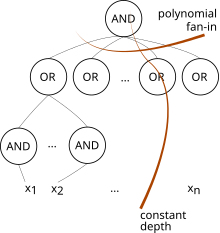


AC0 is a complexity class used in circuit complexity. It is the smallest class in the AC hierarchy, and consists of all families of circuits of depth O(1) and polynomial size, with unlimited-fanin AND gates and OR gates (we allow NOT gates only at the inputs).[1] It thus contains NC0, which has only bounded-fanin AND and OR gates.[1]
Integer addition and subtraction are computable in AC0,[2] but multiplication is not (specifically, when the inputs are two integers under the usual binary[3] or base-10 representations of integers).
Since it is a circuit class, like P/poly, AC0 also contains every unary language.
From a descriptive complexity viewpoint, DLOGTIME-uniformAC0 is equal to the descriptive class FO+BIT of all languages describable in first-order logic with the addition of the BIT predicate, or alternatively by FO(+, ×), or by Turing machine in the logarithmic hierarchy.[4]
In 1984 Furst, Saxe, and Sipser showed that calculating the parity of the input bits (unlike the aforementioned addition/subtraction problems above which had two inputs) cannot be decided by any AC0 circuits, even with non-uniformity.[5][1] It follows that AC0 is not equal to NC1, because a family of circuits in the latter class can compute parity.[1] More precise bounds follow from switching lemma. Using them, it has been shown that there is an oracle separation between the polynomial hierarchy and PSPACE.
|
| |
|---|---|
| Considered feasible |
|
| Suspected infeasible |
|
| Considered infeasible |
|
| Class hierarchies |
|
| Families of classes |
|